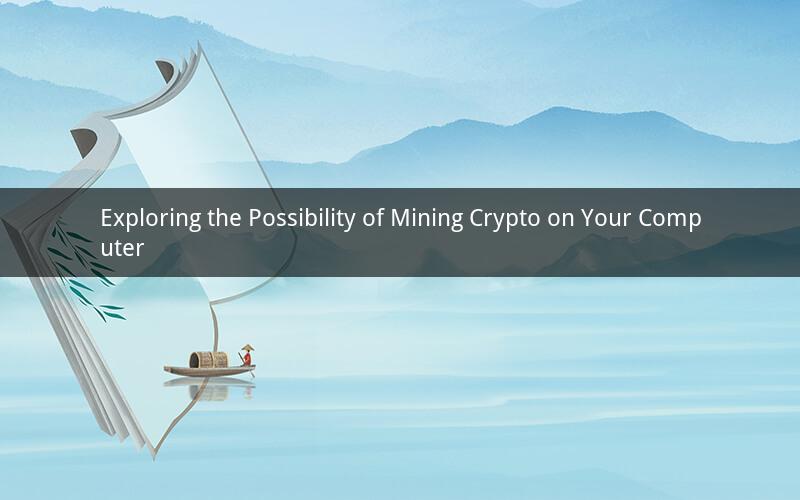
Introduction:
In the rapidly evolving world of cryptocurrencies, many individuals are interested in the prospect of mining digital currencies on their own computers. This article delves into the feasibility of mining crypto on your computer, discussing the hardware requirements, software considerations, and potential challenges.
1. Hardware Requirements for Crypto Mining on Your Computer
The first step in determining whether you can mine crypto on your computer is to evaluate its hardware capabilities. Here are the key components to consider:
a. Graphics Processing Unit (GPU): The GPU is the most crucial component for mining crypto on your computer. GPUs are capable of processing complex mathematical calculations required for mining. High-end GPUs, such as those from AMD and NVIDIA, are generally recommended for efficient mining.
b. Central Processing Unit (CPU): While the GPU is the primary component for mining, the CPU also plays a vital role. A strong CPU will ensure that your computer can handle the demands of the mining process without experiencing performance issues.
c. Motherboard: The motherboard should be compatible with your GPU and CPU, and have sufficient RAM and storage space for the mining software.
d. Power Supply: A reliable and powerful power supply is essential to support the high energy consumption of mining hardware. Ensure that your power supply can deliver enough power to your components without overheating.
2. Software Considerations for Crypto Mining on Your Computer
Once you have the necessary hardware, you need to install mining software on your computer. Here are some popular options:
a. CGMiner: A widely used open-source GPU miner, CGMiner is compatible with various cryptocurrencies and supports both AMD and NVIDIA GPUs.
b. Claymore's Ethereum miner: This software is specifically designed for mining Ethereum and offers high efficiency and performance.
c. NiceHash: An online mining platform that allows you to mine various cryptocurrencies using your computer's GPU. NiceHash automatically adjusts your mining performance based on the current market conditions.
3. Potential Challenges of Mining Crypto on Your Computer
Despite the potential benefits of mining crypto on your computer, there are several challenges to consider:
a. Energy Consumption: Mining crypto requires a significant amount of energy, which can lead to increased electricity bills. Ensure that your electricity costs do not outweigh the potential profits from mining.
b. Hardware Lifespan: The constant use of your computer's GPU can reduce its lifespan. Regular maintenance and monitoring are essential to prevent hardware failures.
c. Market Volatility: The value of cryptocurrencies can be highly volatile, which can impact your mining profits. It's important to stay informed about market trends and adjust your mining strategy accordingly.
4. Mining Pools and the Importance of Joining One
Joining a mining pool can enhance your chances of earning profits from mining crypto on your computer. Here's why:
a. Reduced Risk: Mining pools distribute the workload among multiple participants, increasing the likelihood of finding a block and earning rewards.
b. Stability: Mining pools provide a more consistent income compared to solo mining, as rewards are distributed based on your contribution to the pool.
c. Accessibility: Mining pools make it easier for beginners to start mining, as they provide a more user-friendly experience.
5. Best Practices for Mining Crypto on Your Computer
To maximize your chances of success in mining crypto on your computer, consider the following best practices:
a. Optimize Your Setup: Regularly update your hardware and software to ensure optimal performance. Keep your computer's cooling system in good condition to prevent overheating.
b. Monitor Your Power Consumption: Keep track of your energy usage to minimize costs and ensure your profits remain viable.
c. Stay Informed: Keep up-to-date with the latest market trends and regulatory changes to make informed decisions about your mining strategy.
Conclusion:
Mining crypto on your computer can be a viable option for those looking to earn profits from the digital currency market. By understanding the hardware and software requirements, addressing potential challenges, and adopting best practices, you can enhance your chances of success in this exciting field.
Questions and Answers:
1. What are the primary hardware requirements for mining crypto on my computer?
Answer: The primary hardware requirements include a high-performance GPU, a strong CPU, a compatible motherboard, and a reliable power supply.
2. How do I choose the right mining software for my computer?
Answer: Consider the specific cryptocurrency you wish to mine and choose a mining software that is compatible with your hardware and offers efficient performance.
3. What are the main challenges of mining crypto on my computer?
Answer: The main challenges include high energy consumption, reduced hardware lifespan, and market volatility.
4. Why should I join a mining pool for crypto mining?
Answer: Mining pools reduce the risk of not finding a block, provide stability in rewards, and make mining more accessible for beginners.
5. What are some best practices for mining crypto on my computer?
Answer: Optimize your setup, monitor your power consumption, and stay informed about market trends and regulatory changes.